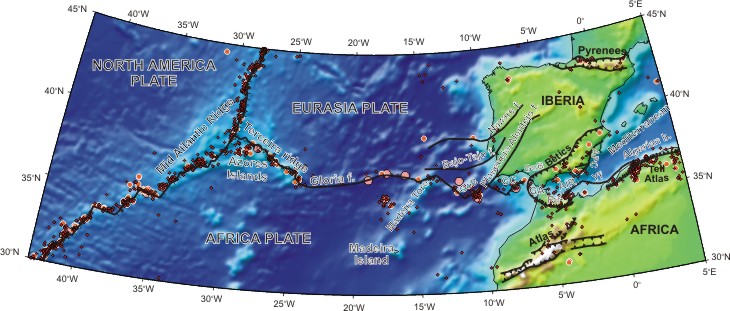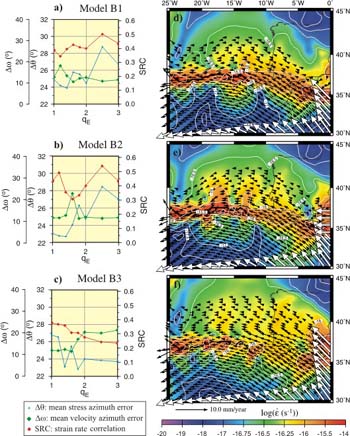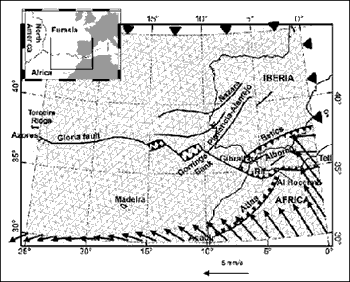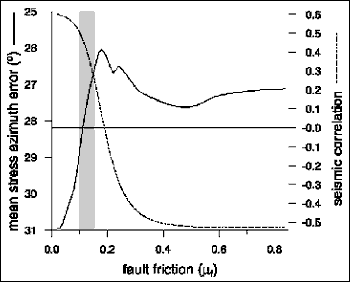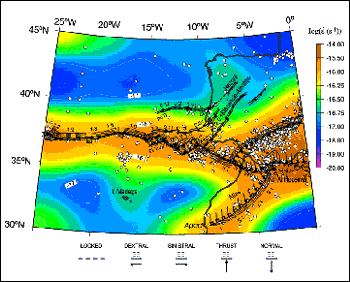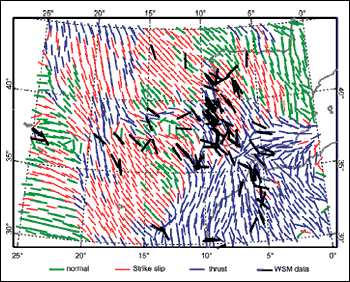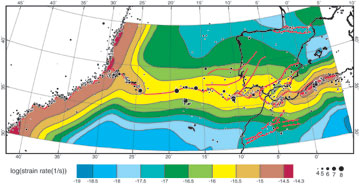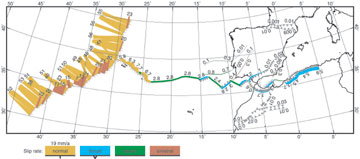| Research Publications Projects Curriculum Links Home |
1. The transition from linear to diffuse plate boundary in the Azores-Gibraltar region: results from a thin sheet model(pdf) We use the thin-sheet plane-stress approach (UHURU) to study the present-day dynamic behaviour of the plate boundary between Eurasia and Africa along the Azores-Gibraltar region. This plate boundary, which extends from the Azores triple junction to the Gibraltar strait, shows a tectonic regime that changes from transtension in the West to transpression in the East, with a strike-slip motion in its central segment. Seismological data reveal that the western and central segments are currently marked by a linear series of earthquakes indicating that the plate boundary is located in a narrow zone. In contrast, the eastern segment is not so well defined and deformation spreads over a much broader area. To apply the thin sheet approach, we combined heat flow, elevation and crustal thickness data to calculate the steady-state geotherm and the total strength of the lithosphere. Several models with different fault friction coefficients and geometries at the eastern segment of the plate boundary were tested. Results are compared with the maximum compressive stress directions from the World Stress Map, and the calculated seismic strain rates and slip vectors from earthquake data. The best fitting models are consistent with the rotation pole of Argus et al. (1989), and show that the rheological behaviour of the plate boundary must necessarily change from the western and central segments to the eastern segment. The diffuse character of the plate boundary east of the Gorringe Bank is dominated by the transition from oceanic to continental lithosphere, the weakness of the Alboran domain, and the convergence between the African and the Eurasian plates. The displacement of the Alboran domain relative to the African plate may play a major role in stress propagation through the Iberian Peninsula and its Atlantic margin.
|
|
|
|
see paper for details: pdf |
2. Thin-shell modeling of neotectonics in the Azores-Gibraltar region(pdf) We applied the thin-shell neotectonic modeling method to study the neotectonics of the Africa/Eurasia plate boundary in the Azores-Gibraltar region. Results are compared with seismic strain rates, fault slip rates and stress orientations. The best estimate for the fault friction coefficient is 0.1-0.15 meaning that the plate-boundary is only about 1/4 as strong as the adjacent lithosphere. The largest fault slip rates (>1.5 mm/yr) are obtained along the Gloria fault (strike-slip), and the Betic (transpressive) and Rif-Tell (compressive) thrust systems. Whereas tectonic activity in the Atlas region is comparable to that obtained along the plate boundary, the fault slip rates in the west Iberia fault systems are one order of magnitude less. |
|
|
|
|
|
|
|
3. Neotectonic modelling of the western part of the Africa-Eurasia plate boundary: from the mid-Atlantic ridge to Algeria(pdf) In this work we use the thin-shell approximation to model the neotectonics of the western part of the Africa/Eurasia plate boundary, extending from the Mid-Atlantic ridge to Tell Atlas (northern Algeria). Models assume a nonlinear rheology and include laterally variable heat flow, elevation, and crust and lithospheric mantle thickness. Including the Mid-Atlantic ridge permits us to evaluate the effects of ridge push and to analyse the influence of the North America motion on the area of the Africa/Eurasia plate boundary. Ridge push forces were included in a self-consistent manner and have been shown to exert negligible effects in the neotectonics of the Iberian Peninsula and northwestern Africa. Different models were computed with systematic variation of the fault friction coefficient. Model quality was scored by comparing predictions of anelastic strain rates, vertically-integrated stresses and velocity fields to data on seismic strain rate computed from earthquake magnitude, most compressive horizontal principal stress direction, and seafloor spreading rates on the Mid-Atlantic ridge. The best model scores were obtained with fault friction coefficients as low as 0.06-0.1. The velocity boundary condition representing spreading on the Mid-Atlantic ridge is shown to produce concentrated deformation along the ridge and to have negligible effect in the interior of the plates. However, this condition is shown to be necessary to properly reproduce the observed directions of maximum horizontal compression on the Mid-Atlantic ridge. The maximum fault slip rates predicted by the model are obtained along the Mid-Atlantic ridge, Terceira ridge and Tell Atlas front. Relatively high slip rates are also obtained in the area between the Gloria fault and the Gulf of Cadiz. We infer from our modelling a significant long-term seismic hazard for the Gloria fault, and interpret the absence of seismicity on this fault as possibly due to transient elastic strain accumulation. The present study has also permitted better understanding of the geometry of the Africa-Eurasia plate boundary from the Azores triple junction to the Algerian Basin. The different deformational styles seem to be related to the different types of lithosphere, oceanic or continental, in contact at the plate boundary. |
|
|
|
|
|
|
